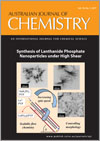
Australian Journal of Chemistry
Volume 70 Number 7 2017
CH16585Formate: A Possible Replacement for Formic Acid in Fuel Cells
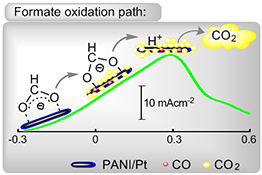
Is formate an energy source? We achieve formate electrooxidation in a practical and convenient way. The precursor of the oxidation is free HCOO– in fuel liquid rather than Pt-HCOOH. Formate is able to bypass the undesirable poisoning path to alternatively form carbon dioxide.
CH16540Synthesis and Liquid Crystalline Properties of a New Homologous Series of 4,5-Disubstituted 2H-[1,2,3]-Triazoles via Azide-Chalcone Oxidative Cycloaddition Reaction
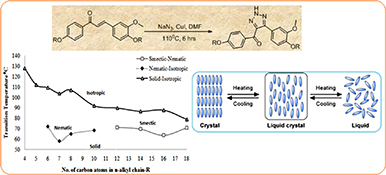
Homologous series of 4,5-disubstituted 2H-[1,2,3]-triazole derivatives were synthesized from chalcones and sodium azide via CuI-catalyzed oxidative cycloaddition reaction in order to characterize their liquid crystalline properties by polarizing optical microscopy and differential scanning calorimetry.
CH16528Platinum(IV) Chloride Complex Ions Adsorption on Activated Carbon Organosorb 10CO
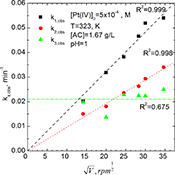
The recovery of platinum from acidic solutions was examined and consists of two steps. For each reaction within a step, the rate constants were determined. The first two reactions in step 1 were diffusion controlled unlike the third reaction in step 2 step, which took place at the surface of activated carbon. The results were in excellent agreement to the assumed model.
CH16643Investigation of Selective Microwave Heating Phenomena in the Reactions of 2-Substituted Pyridines
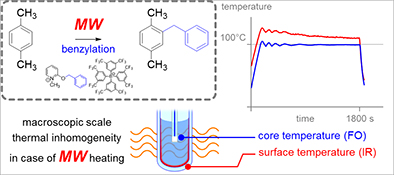
Simultaneous temperature measurement by external and internal sensors revealed hidden inhomogeneities within the reaction mixtures of a debated microwave-assisted benzylation involving a 2-substituted pyridine reagent. Rate enhancement could be explained by macroscopic-scale localized heating in the boundary layers close to the vessel surface.
CH16600Luminescent Functionalised Supramolecular Coordination Polymers Based on an Aromatic Carboxylic Acid Ligand for Sensing Hg2+ Ions
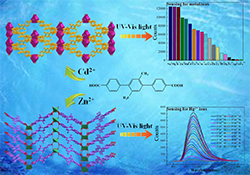
Two luminescent functionalised supramolecular coordination polymers based on an aromatic carboxylic acid ligand exhibit efficient luminescence sensing for Hg2+ ions.
CH16656A Novel, Interpenetrating Metal–Organic Framework: Synthesis, Structure, and Luminescence Detection of Nitrobenzene
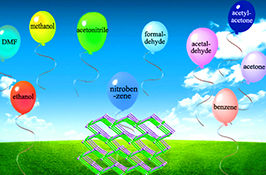
A 3D heterometal–organic framework was synthesised. The compound is 2-fold interpenetrating. It displayed good thermal and solvents stability and exhibited high sensitive and qualitative luminescent detection of nitrobenzene. The present study is the first report on the use of an interpenetrating heterometallic metal–organic framework as a luminescent probe for nitrobenzene
CH16660A Theoretical Probe for Structures, Metal–Metal Bonding, and Electronic Spectra of Paramagnetic Tetrapyrrolic RuII Complex
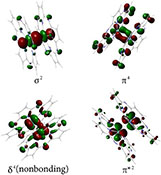
The Ru2 double bond in (RuPz)2, composed of one σ bond and one π bond, is unravelled by DFT (B3LYP) and WFT (CASSCF and NEVPT2) calculations. The ground state shows a Ru–Ru distance of 2.38 Å, a stretching frequency of 202 cm−1, and a bonding energy of 30.7 kcal mol−1. This agrees with experimental results.
CH16704Novel Dual BODIPY-Carbazole Conjugates with Various Linkers
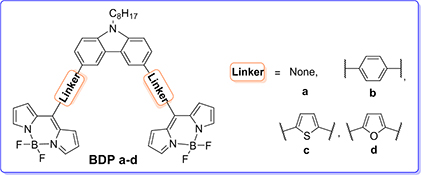
Four dual BODIPY-carbazole conjugates (BDPa–d) with various linkers were synthesized. The results suggest that the linkers have significant effect on the photophysical and electrochemical properties of the conjugates. The conjugates show intensive absorption, remarkable Stocks shifts, and suitable HOMO–LUMO energy levels, which are promising for photovoltaic applications.
CH16682Synthesis of Cross-Linked Poly(acrylamide) Microspheres by Dispersion Polymerisation in Aqueous Ammonium Sulfate Solution
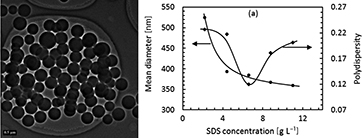
Cross-linked poly(acrylamide) microspheres, PAMBA, with mean diameters ranging from 169.7 to 525.2 nm were successfully prepared by dispersion polymerisation of acrylamide in an aqueous ammonium sulfate solution with N,N′-methylenebis(acrylamide) as the cross-linking agent and sodium dodecyl sulfate as the stabiliser. The mean diameter of the PAMBA microspheres can be controlled by adjusting the concentration of the stabiliser.
CH16692Shear Stress Induced Fabrication of Dandelion-Shaped Lanthanide Phosphate Nanoparticles
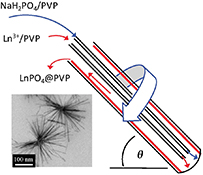
Lanthanide phosphate nanoparticles were produced under continuous flow in a vortex fluidic device in the presence of polyvinylpyrrolidone. Changes in the morphology of the dandelion-shaped nanoparticles were possible by varying the chain length of PVP, and the rotational speed and tilt angle of the tube in the vortex fluidic device.
CH16496DNA Photocleavage and Binding Modes of Methylene Violet 3RAX and its Derivatives: Effect of Functional Groups
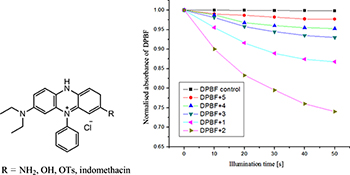
Methylene violet 3RAX 1 and its derivatives 2–5 were synthesised and characterised. The binding mode between the synthesised compounds and DNA and their DNA photocleavage ability were investigated. The results suggest that the binding mode between methylene violet 3RAX and DNA, its ability to generate singlet oxygen, and DNA photocleavage activity could be changed through modification of the amino group on methylene violet 3RAX.
CH16616A Combined Experimental and Theoretical Study on the Reaction Mechanism and Molecular Structure of 4-(Diphenylamino)-3-iodo-2(5H)-furanone
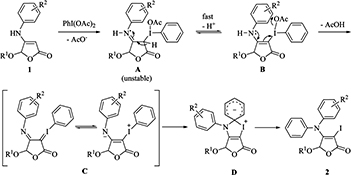
The simultaneous α-iodination and Nβ-arylation mechanism of 5-alkyoxy-4-phenylamino-2(5H)-furanone by (diacetoxyiodo)benzene was investigated by means of density functional theory (DFT), selecting 4-(diphenylamino)-5-methoxy-3-iodo-2(5H)-furanone as the calculation model.
CH165451-(+)-Dehydroabietylimidazolium Salts as Enantiomer Discriminators for NMR Spectroscopy
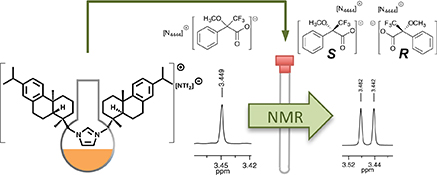
The determination of enantiomeric purity is frequently required in synthetic chemistry. NMR can be used for this purpose if suitable chiral solvating agents are available. Nine new (+)-dehydroabietylimidazolium salts were synthesised and used as efficient chiral solvating agents for resolving several racemic aromatic and non-aromatic carboxylate salts.



